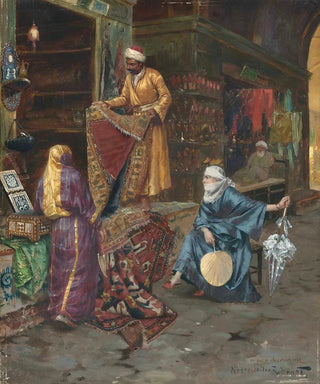Art print | The Carpet Seller - Rudolf Ernst


View from behind

Frame (optional)
In the fascinating world of Orientalist art, the artwork "The Carpet Seller" by Rudolf Ernst stands out for its ability to transport viewers to the heart of a vibrant bazaar, where colors, textures, and emotions intertwine. This scene, imbued with realism and poetry, depicts a carpet merchant surrounded by his treasures, in an atmosphere where time seems to stand still. The soft light flooding the canvas evokes the rays of the sun filtering through tent veils, creating a warm and welcoming ambiance. Through this art print, the piece invites us to explore not only the depicted objects but also the stories and cultures that surround them, opening a window to a world rich in traditions and craftsmanship.
Style and uniqueness of the artwork
Rudolf Ernst's style is characterized by meticulous attention to detail and a palette of vibrant colors that captivate the eye. In "The Carpet Seller," every element, from the patterns of the carpets to the expressions of the characters, is rendered with remarkable precision. The artist manages to create depth and dimension that bring the scene to life, making the viewer almost a participant in the exchange between the seller and his clients. The interplay of shadow and light adds a touch of realism, while the textures, whether of fabrics or surrounding objects, seem almost tangible. This artwork does not merely depict a frozen moment in time; it also evokes a story, a culture, and artisanal craftsmanship that deserve to be celebrated.
The artist and his influence
Rudolf Ernst, born in 1854 in Vienna, established himself as one of the masters of Orientalism in the 19th century. His passion for Eastern cultures led him to travel across the Ottoman Empire and beyond, absorbing the colors, shapes, and atmospheres that he later reproduced in his works. His ability to capture the essence of these places made him famous, and his style influenced many contemporary artists. Ernst does not simply reproduce scenes; he interprets them, infusing his canvases with sensitivity and depth that re

Matte finish

View from behind

Frame (optional)
In the fascinating world of Orientalist art, the artwork "The Carpet Seller" by Rudolf Ernst stands out for its ability to transport viewers to the heart of a vibrant bazaar, where colors, textures, and emotions intertwine. This scene, imbued with realism and poetry, depicts a carpet merchant surrounded by his treasures, in an atmosphere where time seems to stand still. The soft light flooding the canvas evokes the rays of the sun filtering through tent veils, creating a warm and welcoming ambiance. Through this art print, the piece invites us to explore not only the depicted objects but also the stories and cultures that surround them, opening a window to a world rich in traditions and craftsmanship.
Style and uniqueness of the artwork
Rudolf Ernst's style is characterized by meticulous attention to detail and a palette of vibrant colors that captivate the eye. In "The Carpet Seller," every element, from the patterns of the carpets to the expressions of the characters, is rendered with remarkable precision. The artist manages to create depth and dimension that bring the scene to life, making the viewer almost a participant in the exchange between the seller and his clients. The interplay of shadow and light adds a touch of realism, while the textures, whether of fabrics or surrounding objects, seem almost tangible. This artwork does not merely depict a frozen moment in time; it also evokes a story, a culture, and artisanal craftsmanship that deserve to be celebrated.
The artist and his influence
Rudolf Ernst, born in 1854 in Vienna, established himself as one of the masters of Orientalism in the 19th century. His passion for Eastern cultures led him to travel across the Ottoman Empire and beyond, absorbing the colors, shapes, and atmospheres that he later reproduced in his works. His ability to capture the essence of these places made him famous, and his style influenced many contemporary artists. Ernst does not simply reproduce scenes; he interprets them, infusing his canvases with sensitivity and depth that re






